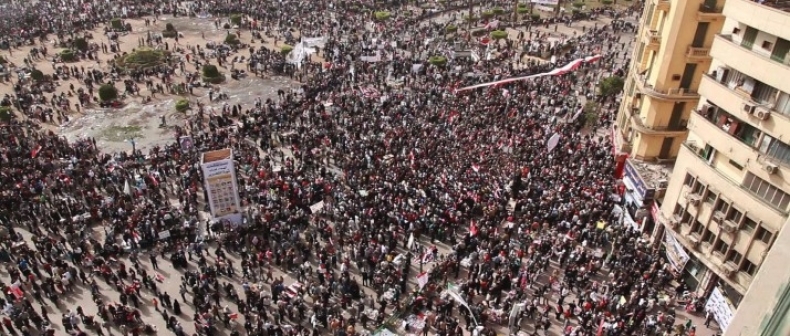
Film still from Tarek Abouamin’s 18 Days (2011)
In each installment of the Contact Festival, there is always a huge group show announcing the theme. For the last little while, these shows have been mounted at the Museum of Contemporary Canadian Art. This year, MoCCA shares the honours with the University of Toronto Art Centre in their joint Collective Identity / Occupied Spaces. The central focus is public space; specifically, how it’s occupied. The MoCCA show is the more deliberately crowd-pleasing of the pair, showcasing Jon Rafman’s found-image plunderings from Google Street View, Barry Frydlender’s crisp, technically astounding panoramas and Michael Wolf’s darkly funny portraits of compressed Tokyo subway riders, among others.
The UTAC show is the politically engaged sibling here, and its timeliness is uncanny. Ground-level upheaval and revolutionary aspiration have been a focus of the public imagination and the media for a while now — the Arab Spring, the Occupy movement. Most people (globally speaking) depend on photographic documentation to participate, however vicariously and remotely, in these events. And right now, almost everyone I know is eagerly consuming images of the student protests in Montreal; on various websites and blogs and of course Facebook, I have been watching a steady stream of photographs of Montreal’s major avenues, completely overtaken by a sea of humanity.
These kinds of documents are usually direct, and un-artful, by which I mean they’ve been taken by non-professionals, and involve little intentional aesthetic intervention (the image has been framed by the camera, but not much else has happened). This (perhaps illusory) sense of direct, unfiltered access is why they are so inspiring. And this notion of aesthetic intervention is what makes the show at UTAC so strange.
Most of the artists in this show are engaged in some kind of documentary practice centred on protest or conflict, and most seem to have some kind of aesthetic twist to their images. Richard Mosse’s Infra series documents eastern Congo: the Tutsi landscape and soldiers. He’s used a special infrared film developed by Kodak in collaboration with the US military; the film swaps green for pink. So soldiers are dressed in pink fatigues, and vegetation is an electric rose. This intervention works in the broader images of landscapes. Vast fields of pink are dotted by swaths of black (earth that was scorched to displace Hunde farmers); the land looks awash in a foamy sea of blood and ash. Elsewhere, however, the seductive brightness of the colour shift creates a decorous formalization, and so the brutal realities that these photos represent have been swapped out for an alluring prettiness. Moreover, this trick of the camera doesn’t itself add to or comment on the conflict at all. These photos seem less about the Congolese war than they do about the inadvertently lovely side-effects of this particular film stock.
Each image of street life in Iraq by photojournalist Benjamin Lowy is taken through the window of a tank. Each has been very carefully framed: the heavy steel borders of the tank’s interior are precisely and evenly measured in each photo. It’s less of an intervention than in Mosse’s photographs, but still, in repetition, this framing device becomes just that: a device, something tricksy that mediates our experience of this photograph, that distances us from the events displayed.
Ai Weiwei’s Study in Perspective series is just puzzling. In a row of small photographs, Weiwei gives the middle finger to a parade of international political and cultural landmarks: the White House, Tiananmen Square, the Eiffel Tower, the Sydney Opera House. I’ve always found that Weiwei’s relentless persecution by the Chinese government has outweighed the impact and substance of his work, and I confess myself mystified by Study in Perspective. A perpetual reiteration of the most perfunctory, puerile gesture of resistance, it’s punkish and bratty and entirely inconsequential, both as an act of rebellion and as a signifier of rebellion’s futility.
The standout installation is Tarek Abouamin’s documentation of the 2011-12 Egyptian revolution, and it shames the rest of the work in the show. One wall is filled edge-to-edge with amateur 4” x 6” snapshots that Abouamin curated from an open call. It’s paired with a video. The video is more-or-less straightforward documentary, and therein lies its power. Of course it’s the product of aesthetic intervention — the video had to be edited into its 18-minute running time, and Abouamin is transparent about the events that he chose to represent — but the intervention clarifies rather than distances. Aboumain edits in order to focus, to draw our attention more specifically and clearly. There is incredible footage here: of protesters breaking down in tears as they declare their desire for basic civil rights; of riot police standing down and joining a protest march; and of Tahrir Square on the evening of Mubarak’s abdication, mobbed with people — an off-camera voice, shaky with ecstatic disbelief, shouts “OH EGYPT! EGYPT! EGYPT!” over and over, eventually resorting to a joyous bellow as words fail to encapsulate the enormity of the moment.
The latter was shot from the balcony of the house that served as Abouamin’s home base, and captures the length and breadth of the square, rammed with jubilant people. It’s a sight that gave me a lump in my throat. Abouamin’s video is by no means naïve — it captures some fairly horrific images as well — but it demonstrates the power of a population to exercise their hopes, and translate them into political reality. A few elderly gallery-goers walked in the room as I watched, and one of them said to the other, “groups of people that large make me nervous.” Imagine how Mubarak felt.
______
Sholem Krishtalka is the Toronto Standard’s art critic.
For more, follow us on Twitter at @torontostandard, and subscribe to our newsletter.











